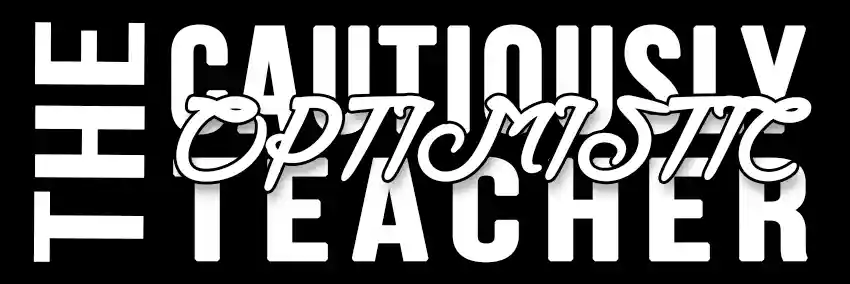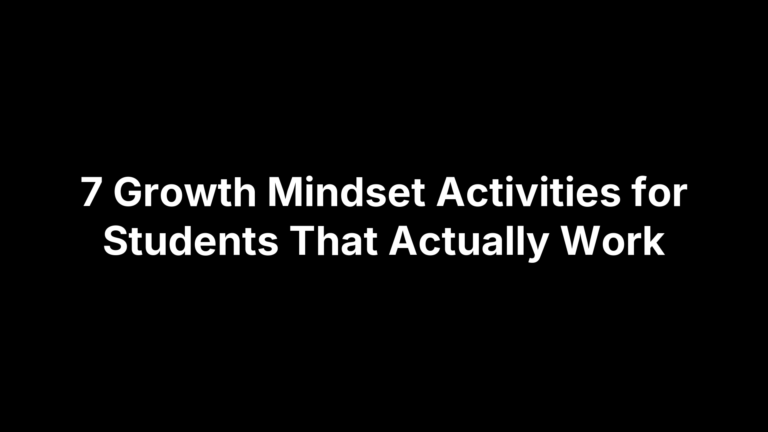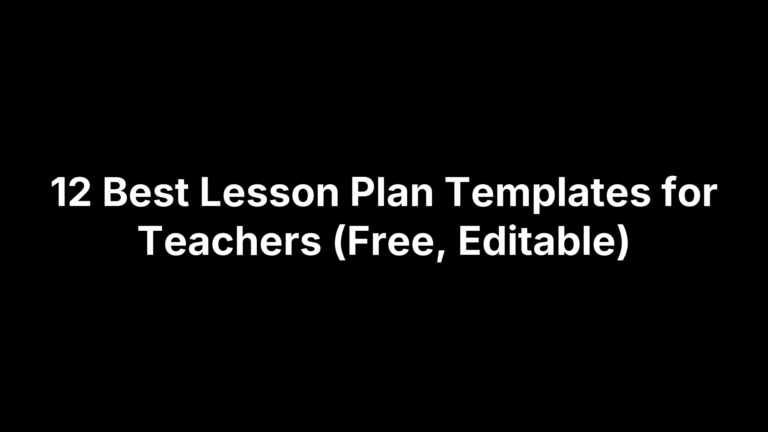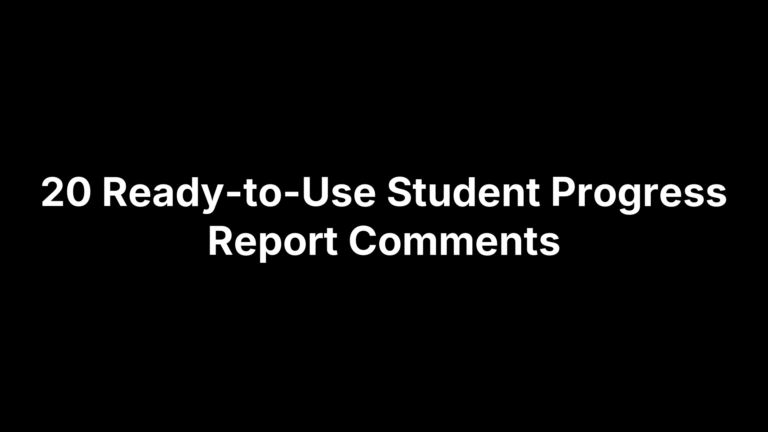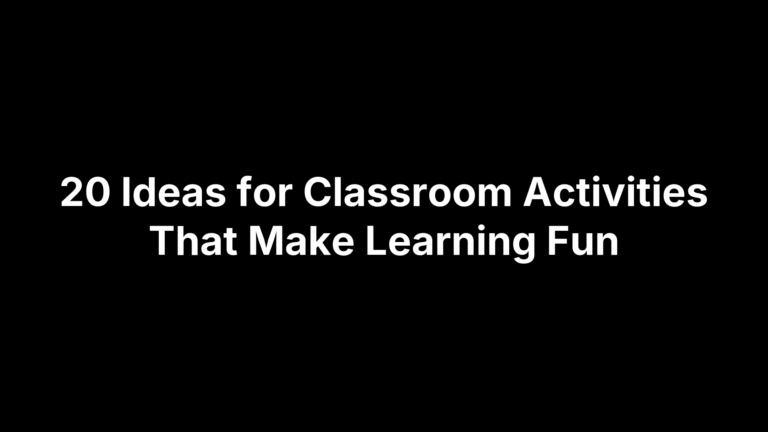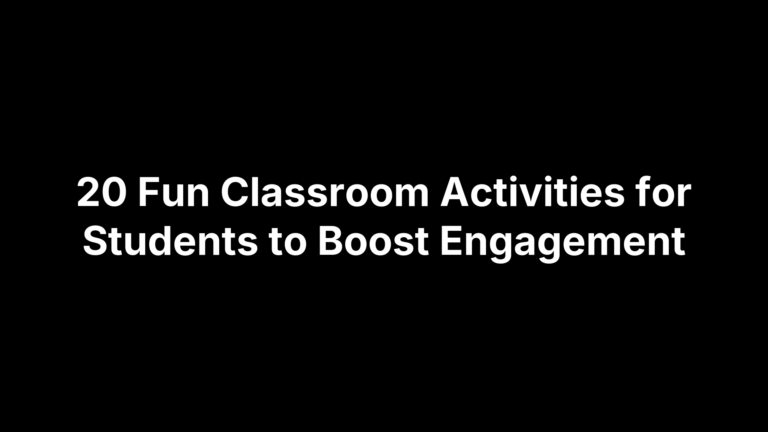Strategies for Student Motivation: 20 Classroom-Proven Tips
When the bell rings, you know instantly whether the day will glide or grind. Some classes lean in, eyes bright; others slump, phones creeping from pockets. That gap nearly always comes down to motivation—something you can influence.
Below you’ll find 20 classroom-proven strategies that consistently boost student motivation, engagement, and achievement across grade levels. They don’t require expensive programs or marathon planning sessions—just small, intentional moves grounded in research and refined by working teachers.
Whether you teach kindergarten centers, AP physics, or anything in between, you’ll walk away with ideas you can implement tomorrow morning. Scan the list, pick one or two tactics that fit your style, and watch participation jump without the usual tug-of-war. Let’s get straight to the tips.
Pressed for time? Start with quick wins—greet students at the door, celebrate micro-successes, and turn drills into mini-games. Ready for deeper change? Try goal-setting conferences, peer mentoring, or a project that links the unit standard to a real community problem. The menu is flexible, but the outcome is the same: students who see purpose, feel capable, and choose to engage.
1. Build Positive Relationships and Know Your Students
The fastest-acting strategies for student motivation start with human connection. When learners feel seen and valued by the adult in the room, they’re far more willing to attempt hard work, ask questions, and risk a wrong answer.
Why Relationships Drive Motivation
According to Self-Determination Theory, motivation flourishes when three needs are met: autonomy, competence, and relatedness. That last piece—relatedness—hinges on teacher-student rapport. A 2023 meta-analysis found classes with high relational trust showed up to a 30 % jump in on-task behavior and improved grades across subjects.
Low-Prep Ways to Get to Know Students
- Hand out a one-page interest inventory on day one; skim it before planning examples.
- Try “Two-Minute Talks”: spend the first 120 seconds of class chatting with a different student each day.
- Greet students at the door by name, eye level, and a quick question about yesterday’s game, show, or hobby.
Quick Example
Add three survey questions—“Favorite way to learn,” “Current obsession,” and “Biggest school worry.” When Luis writes “learning through memes,” work a meme analysis into tomorrow’s vocabulary warm-up. He sees himself in the lesson, and motivation spikes.
2. Set Clear, Achievable Goals Together
Nothing blunts effort faster than hazy expectations. When teacher and students co-write precise targets, learners can see the finish line and chart a route—one of the simplest strategies for student motivation you can deploy.
From Big Picture to Daily Targets
Start with the unit’s anchor outcome, then break it into bite-sized success criteria students can accomplish in a single class. Post both on the board: “Write a persuasive essay” cascades to today’s micro-aim, “Draft a thesis with two supporting reasons.”
Co-Creating Goals With Students
Use a quick SMART template on a shared doc. Example: “By Friday, I will solve 10 multi-step equations with 85 % accuracy.” Students pick the number and accuracy level after reviewing prior data, giving them ownership.
Monitoring and Reflecting
Hold five-minute weekly conferences or leverage digital trackers like Google Sheets with conditional-format cells that turn green when goals are met. Finish with a reflection prompt—“What worked? What’s next?”—to reinforce self-regulation.
3. Connect Learning to Real-World Relevance
Few phrases sink motivation faster than “When will I ever use this?” Flip that script by consistently tying academic standards to situations students actually encounter beyond your door.
Why Relevance Fuels Intrinsic Interest
Brain-imaging studies show dopamine spikes when learners spot a link between content and their goals. Relevance signals utility, which in turn feeds the autonomy and competence drivers outlined in Self-Determination Theory. Whether it’s seeing algebra inside a TikTok algorithm or spotting literary themes in Top 40 lyrics, meaningful connections turn “school work” into “my work.”
Classroom Techniques
- Launch units with a puzzling real headline or viral clip.
- Invite career guests—graphic designers for geometry, forensic analysts for biology.
- Use project-based learning that tackles authentic community needs.
- Let students choose contexts (sports stats, fashion budgets, gaming physics) while mastering the same rubric.
Example Hook
Before a linear-equations lesson, challenge the class to plan a one-day music festival: book artists, price tickets, and forecast profit—all solved through y = mx + b.
4. Offer Student Choice and Voice
Choice is rocket fuel for engagement; when learners help steer the route, they invest more energy in reaching the destination. Among the most effective strategies for student motivation is intentionally building spaces where autonomy and expression live side by side.
Choice Boards & Learning Menus
A simple 3 × 3 board lets students choose any three tasks in a row, column, or diagonal while still hitting the same standard. Vary the options by
- content (video, article, podcast)
- process (solo sketch-note, partner lab, small-group debate)
- product (infographic, essay, screencast).
This structure keeps rigor constant yet honors preference.
Amplifying Voice
Hand the mic over: rotate student-led discussions, host five-minute “hot seat” expert interviews, or publish reflections on a class blog or podcast. When learners hear their own ideas echoed back, ownership skyrockets.
Guardrails
Autonomy doesn’t mean anarchy. Provide clear rubrics, mid-point checkpoints, and peer feedback rounds so creativity stays aligned with learning targets. As confidence rises, gradually widen the lanes.
5. Use Growth Mindset Language
Words are free, but they’re powerful levers for motivation. A casual “You’re a natural” can lock students into avoiding risk, while “Your strategy paid off” reinforces effort as the path to success. Switch the script and watch persistence climb.
Shifting Mindset
Carol Dweck’s studies show students who view ability as malleable tackle harder tasks, recover faster from setbacks, and outperform fixed-mindset peers. Reframing challenge as a chance to grow satisfies the competence driver in Self-Determination Theory.
Practical Phrasing
- Replace “Wrong” with “Not yet—let’s revise.”
- Swap “You’re smart” for “Your practice is showing.”
- Ask “What skill improved?” instead of “What grade did you get?”
- Praise strategy: “Chunking that problem was a clever move.”
Classroom Culture Moves
Schedule five-minute error-analysis sessions, spotlight a “Favorite Mistake” each week, and model your own learning curve. Visible vulnerability normalizes struggle, turning setbacks into stepping-stones rather than stop signs.
6. Scaffold Tasks and Celebrate Small Wins
Big goals feel manageable when broken into bite-sized victories. Strategic scaffolds keep frustration low and momentum high, making this one of the quickest strategies for student motivation you can add tomorrow.
The Power of Early Success
According to cognitive load theory, novices have limited working memory. Quick victories lighten the mental load, releasing dopamine that nudges them to attempt the next rung.
Scaffolding Techniques
Move through an “I do, we do, you do” gradual release. Provide worked examples to model thought processes, then hand students partial problems with sentence stems such as “First, I notice…”. Strip away supports as accuracy rises.
Celebration Ideas
Mark every milestone: add a sticker to a class progress wall, issue digital micro-badges, or give a 15-second shout-out during clean-up. Tiny spotlights compound confidence without derailing instructional time.
7. Incorporate Gamification Elements
A dash of game design can turn routine practice into an activity students can’t wait to start. When used thoughtfully, points, stories, and levels hit the same dopamine pathways that keep kids glued to apps—making gamification one of the fastest-acting strategies for student motivation.
Mechanics That Motivate
- XP (experience points) for finishing tasks
- Levels that unlock new challenges or responsibilities
- Badges for mastering specific skills
- Leaderboards that track personal bests, not just top scores
These mechanics signal immediate progress and create low-stakes opportunities to fail, retry, and improve.
Designing a Simple Classroom Game
- Pick a theme that resonates—space travel, detective work, cooking show.
- Map standards to quests; each quest earns
10–50XP. - Set level thresholds (
Level 2 = 100 XP) that automatically grant perks like homework passes or the right to choose playlist music. - Track XP on a shared spreadsheet or a wall chart for instant visual feedback.
Avoiding Pitfalls
Keep competition healthy by spotlighting growth: display “Most Improved” columns, allow team bonuses, and reset leaderboards each unit. Guard against point inflation—rewards lose power if every action scores big. Finally, invite student co-design; their input ensures the game stays challenging, fair, and fun.
8. Implement Cooperative Learning Structures
Few moves boost energy faster than turning a solo grind into a shared mission. Well-designed cooperative tasks tap social motivation, let students teach one another, and create the positive pressure of not wanting to let the team down. When peers depend on each member’s contribution, even reluctant learners lean in.
Why Collaboration Works
Research on social interdependence theory shows that group goals paired with individual accountability raise achievement more than competitive or isolated work. Students rehearse communication, leadership, and conflict-resolution skills while solidifying content knowledge.
Go-To Structures
- Jigsaw – each student becomes an “expert” on one chunk, then teaches their home team.
- Think-Pair-Share – private processing, partner check, public share-out.
- Numbered Heads Together – teams discuss, teacher calls a random number to respond, keeping everyone prepared.
Managing Groups
Set clear roles (facilitator, recorder, materials manager), use two-minute reflection protocols to surface teamwork issues, and rotate responsibilities weekly to prevent freeloading. Visible rubrics that grade both product and collaboration keep accountability front and center.
9. Differentiate Instruction for Diverse Needs
No two brains in your room share the same prior knowledge, language background, or processing speed. Differentiation respects that reality, giving every learner an entry point and a growth path—core to any stack of strategies for student motivation.
Meeting Students Where They Are
Vygotsky called it the Zone of Proximal Development: the sweet spot where a task is tough enough to stretch thinking but not tough enough to trigger shutdown. Scan data, conferring notes, and informal checks help you pitch tasks inside that zone, ensuring equity instead of one-size-fits-few.
Differentiation Methods
- Readiness: Tiered tasks with increasing complexity
- Interest: Learning centers aligned to survey data
- Learning Profile: Choice of modality—audio, graphic, kinesthetic
Anchor everything to the same rubric so expectations stay high for all.
Tools & Resources
Graphic organizers, adjustable scoring guides, and adaptive tech like text-to-speech or leveled digital libraries let you tailor content on the fly without ballooning prep time.
10. Integrate Technology Thoughtfully
Tablets, Chromebooks, and AI tools grab attention, but novelty fades if tech lacks intention. Used strategically, digital platforms amplify the strategies for student motivation you’re already running—speeding feedback, widening audience, and letting students create artifacts that feel authentic.
Tech as a Motivational Lever
- Interactive simulations make abstract ideas concrete (PhET, GeoGebra).
- Instant feedback quizzes turn practice into a game-like loop of try-see-adjust.
- Student-created media—podcasts, memes, VR tours—push learners from consumers to producers.
App Selection Criteria
Run every tool through a quick SAMR check: will it Substitute, Augment, Modify, or Redefine the task? Add two non-negotiables: data privacy compliance and built-in accessibility (captions, screen-reader compatibility).
Sample Workflow
Flipgrid reflection → auto-caption review for accuracy → Google Jamboard brainstorm → export frames to Canva for a class ebook. One sequence, multiple modalities, zero lost engagement.
11. Make Learning Visible With Progress Tracking
Effort feels pointless when gains stay hidden; show growth and students chase the next tick mark. Progress tracking turns abstract learning into concrete evidence they can celebrate—one of the simplest strategies for student motivation you can launch today.
Visual Motivation
Called the goal-gradient effect, motivation accelerates as people see the finish line. Progress bars, sticker charts, or level meters provide dopamine doses that keep learners moving when tasks get tough.
Tracking Formats
- Color-coded data folders
- Wall charts that slide names up skill ladders
- Auto-updating digital dashboards (Sheets, Canva) that pull scores from quick quizzes
Student Reflection Prompts
Ask learners to annotate their tracker each Friday:
- “What strategy pushed your marker forward?”
- “Where did you stall and why?”
- “What’s one micro-goal for next week?”
12. Provide Immediate, Constructive Feedback
Timely, actionable feedback is one of the highest-impact strategies for student motivation—John Hattie pegs it at an effect size of 0.70. When learners see exactly what to tweak while the task is still fresh, effort feels purposeful and improvement feels attainable.
Feedback ≠ Grades Alone
Skip the cryptic “87 %.” Effective notes are specific (“Vary sentence openings”), positive (“Your evidence is solid”), and forward-looking (“Try a counter-example next draft”).
Rapid Feedback Routines
- Color-code live in Google Docs
- Two-question exit ticket: “Where did you excel?” “Where are you stuck?”
- Use a document camera to annotate an anonymous sample in 90 seconds.
Encouraging Response to Feedback
Embed revision time: students paraphrase comments in a “next-step log,” highlight the fix, then conference for one minute to confirm growth. Reflection turns feedback into feed-forward.
13. Leverage Peer Teaching and Mentoring
Turning students into teachers multiplies engagement while lightening your direct-instruction load. Even reluctant learners lean in when a classmate depends on their explanation, and the “expert” gains confidence from being viewed as a resource.
Why Peer Instruction Motivates Both Parties
Studies on the learning-by-teaching effect show a 20-30 % retention boost for tutors because explaining requires deeper processing. For tutees, hearing content in a peer’s voice feels safer and more relevant. Both roles tick the relatedness and competence boxes of Self-Determination Theory, creating a virtuous cycle of effort and affirmation.
Structures to Try
- Study Buddies: Pairs with complementary strengths meet twice a week to reteach recent skills.
- Cross-Age Tutoring: Older students coach younger ones on fluency, gaining leadership hours; younger students get a relatable role model.
- Peer Review Circles: Groups trade drafts, use color-coded rubrics, and end with one “glow” and one “grow” comment each.
Training Students
Model effective questioning (“How did you get that step?”), give feedback sentence stems, and role-play a five-minute tutoring session. Finish with reflection logs so mentors note what worked and set a focus for the next round.
14. Create a Safe Space for Risk-Taking
Students won’t stretch for higher-order thinking if they fear public embarrassment. A classroom that treats errors as data, not drama, unlocks creativity and is a cornerstone of effective strategies for student motivation.
Psychological Safety Defined
Psychological safety means learners believe they can ask, answer, or challenge without ridicule. Research from Google’s “Project Aristotle” shows teams—and classes—perform best when every voice can surface half-formed ideas without backlash.
Building Safety
- Open the year with a co-constructed “How We Treat Mistakes” charter.
- Keep an anonymous question box (digital or cardboard) for “I’m lost” notes.
- Hang an “Errors Are Welcome” poster and reference it during think-alouds.
- Start discussions with a low-stakes poll so everyone speaks before debate heats up.
Responding to Mistakes
When an answer misses the mark, praise the intellectual risk (“Thanks for pushing our thinking”) and unpack the misconception together. Run two-minute failure debriefs—What happened? Which strategy fixes it?—while modeling your own slip-ups (“I forgot to carry the negative”). Students learn that getting it wrong is part of getting it right.
15. Use Intrinsic and Extrinsic Rewards Strategically
Done well, rewards keep momentum high without turning learning into a points-chase. Done poorly, they can undercut curiosity. The key is intentional design: use external perks to jump-start effort, then pivot to internal satisfaction once the habit sticks.
Balancing Both Types
Intrinsic rewards—pride, mastery, purpose—drive long-term engagement; extrinsic rewards can spark short bursts of effort. Research on the overjustification effect warns that constant prizes may shrink intrinsic drive, so pair tangible incentives with reflection on “why this skill matters to me.”
Smart Reward Systems
Mix low-cost, value-aligned incentives to reinforce your strategies for student motivation:
- Token economy tied to class norms (helping, persistence)
- Random “raffle tickets” for unprompted acts of grit
- Non-material perks: playlist DJ, comfy-chair pass
- Public shout-outs highlighting strategy, not just score
Gradual Fading
As behaviors become routine, step down external cues: double the tokens required, switch to intermittent reinforcement, and replace prizes with self-assessment prompts like “What achievement are you most proud of today?” Motivation shifts from your ledger to their inner scoreboard.
16. Incorporate Student Interests and Identity
Motivation soars when students recognize themselves in the curriculum. By weaving cultural backgrounds, hobbies, and emerging passions into daily learning, you move beyond “relevance” and give every learner a sense of ownership and pride.
Identity-Affirming Curriculum
- Audit examples, texts, and visuals for diverse voices—aim for mirrors (self-reflection) and windows (peer understanding).
- Connect standards to community assets: local artists in art class, neighborhood history in social studies.
- Use name-story activities or heritage timelines to position culture as academic capital.
Interest Surveys to Lesson Hooks
- Issue quick Google Forms asking about music, games, causes, careers.
- Tag responses; pull one hook per lesson (“Fraction practice using sneaker resell prices”).
- Rotate shout-outs so each student hears their pick spotlighted at least once a month.
Student-Generated Content
- Launch Genius Hour or passion-project Fridays tied to rubric skills.
- Offer “Teach the Teacher” mini-lessons where students lead a ten-minute demo on a personal expertise.
- Compile projects into a class podcast or zine, giving authentic audiences to individual identities.
17. Use Formative Assessment to Guide Instruction
Formative data is your instructional GPS: it tells you where students are now so you can plot the next exit—not deliver a post-unit autopsy. When these checks are visible and low-stakes, they become one of the quickest strategies for student motivation, showing learners evidence of progress while it still matters.
Assessment as Motivation, Not Anxiety
Frame every check as feedback for future action, not a grade. Say it aloud: “This quiz helps me see what to reteach and helps you spot what to practice.” When stakes drop, honesty and effort rise.
Quick Checks
- Fist to Five: hold up 0–5 fingers to signal confidence
- One-minute essay on a sticky note
- Drag-and-drop Google Form question that autogrades
- Color-coded dots on an exit poster (green/gold/red)
Adjusting in Real Time
Scan results during the bell-ringer, group kids by need, and pivot: reteach with a mini-lesson, set up practice stations, or push ready students into an enrichment challenge.
18. Teach Self-Regulation and Metacognition
The ultimate win is when students push themselves without a nudge from you. Explicitly teaching them how to plan, monitor, and adjust their own learning turns every other strategy for student motivation into a self-sustaining habit.
Building Independent Motivation
Guide learners through a simple cycle: set a specific goal, choose a tactic, track evidence, and reward progress. Pair this with short reflections—“What helped?” or “What will I tweak?”—so they start connecting strategies with results and internalizing the payoff.
Classroom Practices
- Daily learning journals with prompts like “What did I notice about my focus today?”
- Metacognitive question stems posted on desks (“Does this make sense?” “How else can I solve it?”).
- A quick traffic-light self-assessment: green = got it, yellow = need practice, red = stuck.
Gradual Release of Responsibility
Move from teacher-led reflections to student-designed checklists and study plans; by semester’s end, they’re steering their own improvement roadmap.
19. Involve Families and Communities
Motivation doesn’t end at 3 p.m.; when families and local partners echo classroom goals, effort doubles. A quick text home or a community guest speaker can flip persistence from “maybe” to “absolutely.”
Home-School Connection and Motivation
Epstein’s framework identifies six avenues—parenting, communicating, volunteering, learning at home, decision-making, and community collaborations—that correlate with higher attendance and grades. Tapping even one pathway boosts students’ sense of relevance and accountability.
Practical Touchpoints
- Weekly “learning snapshot” emails with one win, one goal
- Two-question family feedback Google Form every unit
- “Community expertise” days: parents or local pros demo real-world uses of the standard
Inclusive Strategies
Offer multilingual messages via free translation apps, schedule virtual or after-hours meetings for caregivers on shifting shifts, and co-host culturally respectful events—like potluck curriculum nights—that celebrate families as co-teachers rather than spectators.
20. Design an Engaging Physical Environment
Four walls and a ceiling do more than hold a class; the setup silently tells students whether learning is expected to be passive or electric. Treat the room as a co-teacher—one that can either drain or fuel every other strategy you use.
Environment as the “Third Teacher”
Studies on environmental psychology link warm lighting, pops of color, and movable furniture to higher on-task behavior and creativity. A simple switch from overhead fluorescents to lamp corners or adding a calming blue accent wall can lift mood and stamina without touching the lesson plan.
Low-Cost Tweaks
- Create seating zones: collaboration tables, quiet nooks, and stand-up stations.
- Invite students to design wall art that visualizes current units; rotation keeps it fresh.
- Clear clutter; visible surfaces reduce cognitive overload and make transitions faster.
Accessibility & Equity Considerations
Apply UDL checkpoints: ensure aisles fit mobility devices, post visual schedules for neurodivergent learners, and provide noise-dampening headphones. When every body and brain can navigate the space comfortably, the physical environment becomes one of the most inclusive strategies for student motivation you can offer.
Next Steps for an Energized Classroom
Motivation is a moving target, but you now have a quiver of 20 proven arrows. Resist the urge to fire them all at once. Instead, choose two or three strategies that fit your personality and your students’ most pressing needs—maybe greeting every learner at the door, adding a Friday goal-reflection, or swapping tomorrow’s worksheet for a quick Jigsaw. Track the impact for a week, gather student feedback, then iterate. Small, intentional tweaks compound quickly; within a month you’ll notice lean-ins where yawns used to live.
As momentum builds, layer in the longer-range moves—family partnerships, passion projects, or a fresh room layout—to maintain that upward spiral. Remember, the goal isn’t perfection; it’s consistent progress toward a classroom where effort feels worthwhile and success feels possible.
Hungry for ready-to-use templates, AI-powered planning tools, and weekly inspiration? Swing by The Cautiously Optimistic Teacher and grab free resources that make staying motivated—yours and your students’—just a little easier.
